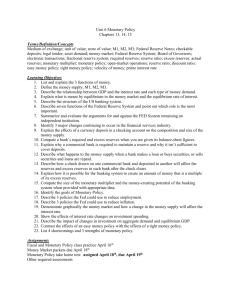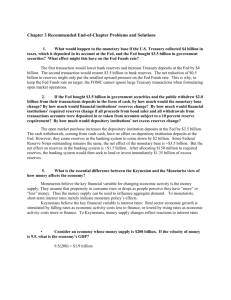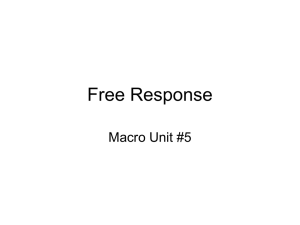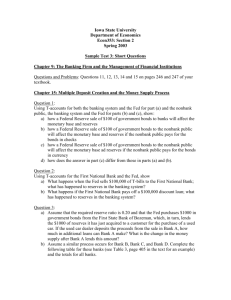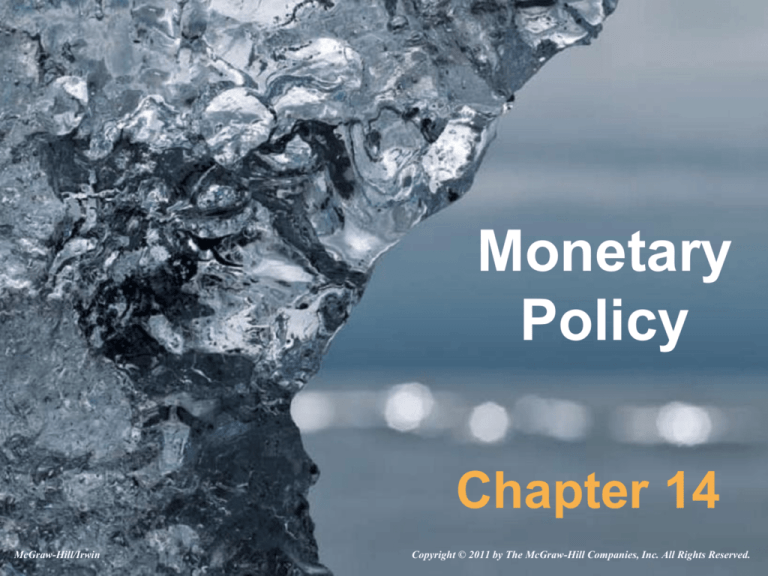
Monetary
Policy
Chapter 14
McGraw-Hill/Irwin
Copyright © 2011 by The McGraw-Hill Companies, Inc. All Rights Reserved.
The Federal
Reserve System
• The Federal Reserve System (the
Fed) is the central banking system of
the United States
• Created in 1913, it consists of two
components:
– Headquarters in Washington, D.C.
– 12 District Banks
LO-1
14-2
Monetary Policy
• A central responsibility of the Federal
Reserve is monetary policy—the use
of money and credit controls to
influence macroeconomic activity.
LO-1
14-3
Figure 14.1
14-4
Federal Reserve
District Banks
• The 12 district banks perform many
critical services, including the following:
– Clearing checks between private banks
– Holding bank reserves
– Providing currency
– Providing loans (called discounting)
LO-1
14-5
Figure 14.2
14-6
The Board of Governors
• The key decision maker for monetary
policy.
• Located in Washington, D.C
• Consists of seven members appointed
by the President and confirmed by the
U.S. Senate.
• Board members are appointed for 14year terms and cannot be reappointed.
• Terms are staggered every two years.
LO-1
14-7
The Fed Chairman
• The Chairman is the most visible
member of the Federal Reserve
System.
• This person is selected by the
President for a four-year term and may
be reappointed.
• Ben Bernanke is the current Chairman
of the Fed.
LO-1
14-8
Monetary Tools
• The Fed has the power to alter the
money supply through three tools:
– Reserve requirements
– Discount rate
– Open market operations
LO-2
14-9
Reserve Requirements
• By changing the reserve requirement,
the Fed can directly alter the lending
capacity of the banking system.
– Required reserves are the minimum
amount of reserves a bank is required to
hold by government regulation.
LO-2
14-10
Reserve Requirements
• The ability of the banking system to
make additional loans (create deposits)
is determined by the amount of excess
reserves banks hold and the money
multiplier:
Available lending
capacity of the
banking system
=
Money
Excess
x
multiplier
Reserves
LO-2
14-11
Reserve Requirements
• A decrease in required reserves
directly increases excess reserves.
• Excess reserves are bank reserves in
excess of required reserves:
Excess
=
reserves
Total
reserves
Required
–
reserves
LO-2
14-12
Decrease in
Required Reserves
• A change in the reserve requirement
causes:
– A change in excess reserves
– A change in the money multiplier
LO-2
14-13
Table 14.1
14-14
Decrease in
Required Reserves
• A lower reserve requirement increases
the value of the money multiplier:
• Money Multiplier =
1
Reserve
Requirement
Ratio
LO-2
14-15
The Discount Rate
• The discount rate is the rate of
interest charged by the Federal
Reserve Banks for lending reserves to
private banks.
• Sometimes bank reserves run low and
they must replenish their reserves
temporarily.
LO-2
14-16
The Discount Rate
• There are three sources of last-minute
extra reserves:
– Federal Funds Market, where banks may
borrow from a reserve-rich bank
– Securities Sales
– Discounting–obtaining reserve credits
from the Federal Reserve System
LO-2
14-17
The Discount Rate
• By raising or lowering the discount
rate, the Fed changes the cost of
money for banks and the incentive to
borrow reserves.
LO-2
14-18
Open-Market Operations
• Open-market operations are the
principal mechanism for directly
altering the reserves of the banking
system.
• Open-market operations are designed
to affect portfolio decisions and the
decision to hold money or bonds.
LO-3
14-19
Figure 14.5
14-20
Hold Money or Bonds?
• The Fed attempts to influence whether
individuals hold idle funds in
transaction accounts (in banks) or
government bonds.
• Changes in bond prices alter portfolio
choices.
LO-3
14-21
Open-Market Activity
• Open-market operations–Federal
Reserve purchases and sales of
government bonds for the purpose fo
altering bank reserves:
– If the Fed buys bonds, it increases bank
reserves.
– If the Fed sells bonds, it reduces bank
reserves.
LO-3
14-22
Powerful Levers
• To summarize, there are three levers
of monetary policy:
– Reserve requirements
– Discount rates
– Open-market operations
• The Fed has effective control of the
nation’s money supply.
LO-2
14-23
Shifting Aggregate
Demand
• The ultimate goal of all macro policy is
to stabilize the economy at its fullemployment potential.
• Monetary policy may be used to shift
aggregate demand.
LO-4
14-24
Shifting Aggregate
Demand
• Aggregate demand is the total
quantity of output demanded at
alternative price levels in a given time
period, ceteris paribus.
LO-4
14-25
Expansionary Policy
• Monetary policy can be used to move
the economy to its full-employment
potential.
• The Fed can increase AD (by
increasing the money supply) by:
– Lowering reserve requirements
– Dropping the discount rate
– Buying more bonds to increase bank
lending capacity
LO-4
14-26
Expansionary Policy
• As a result of the near financial
meltdown and recession of 2008-09,
the Fed took on a massive
expansionary policy by expanding its
balance sheet (purchasing many
government securities and nongovernment assets) and lowering
interest rates to historic levels.
LO-4
14-27
Restrictive Policy
• Monetary policy can also be used to
cool an overheating economy.
• The Fed can decrease AD (by
decreasing the money supply) by:
– Raising reserve requirements
– Increasing the discount rate
– Selling bonds in the open market
LO-4
14-28
Interest-Rate Targets
• Interest rates are a key link between
changes in the money supply and
shifts of the AD curve.
LO-4
14-29
Price versus
Output Effects
• The success of monetary policy
depends on the conditions of
aggregate demand and aggregate
supply.
LO-4
14-30
Aggregate Demand
• Increases in the money supply shift AD
to the right.
LO-4
14-31
Aggregate Supply
• Aggregate supply is the total quantity
of output producers are willing and able
to supply at alternative price levels in a
given time period, ceteris paribus.
• The shape of the AS curve determines
the effectiveness of expansionary
monetary policy.
LO-5
14-32
Aggregate Supply
• Horizontal AS–output increases without
any inflation.
• Vertical AS–inflation occurs without
changing output.
• Upward-sloped AS–both prices and
output are affected by monetary policy.
LO-5
14-33
Aggregate Supply
• With an upward-sloping AS curve,
expansionary policy causes some
inflation, and restrictive policy causes
some unemployment.
LO-5
14-34
Figure 14.7
14-35
Fixed Rules or
Discretion?
• The shape of the aggregate supply curve
spotlights a central policy debate.
• Should the Fed try to fine-tune the economy
with constant adjustments of the money
supply?
• Or should the Fed instead simply keep the
money supply growing at a steady pace?
• The near financial meltdown of 2008 has
raised the tone of this debate.
LO-5
14-36
Discretionary Policy
• The economy is constantly beset by
positive and negative shocks.
• There is a need for continual
adjustments to the money supply.
LO-5
14-37
Fixed Rules
• Critics of discretionary monetary policy
raise objections linked to the shape of
the AS curve.
• The AS curve could be vertical or at
least upward-sloping.
• With an upward-sloping AS curve, too
much expansionary monetary policy
leads to inflation.
LO-5
14-38
Fixed Rules
• Fixed rules for money-supply
management are less prone to error
than discretionary policy.
• The Fed should increase the money
supply by a constant (fixed) rate each
year.
– This idea was supported by economists
such as Milton Friedman.
LO-5
14-39
The Fed’s Eclecticism
• The Fed currently uses a pragmatic,
eclectic approach of:
– Flexible rules
– Limited discretion
• The Fed mixes money-supply and
interest-rate adjustments to do
whatever is necessary to promote price
stability and economic growth.
LO-5
14-40
Inflation Targeting
• Ben Bernanke, the current Fed
Chairman, has been a bit more specific
about the Fed’s policy.
• He believes the Fed should set an
upper limit on inflation (called inflation
targeting), then manipulate interest
rates and the money supply to achieve
it.
LO-5
14-41
End of
Chapter 14



